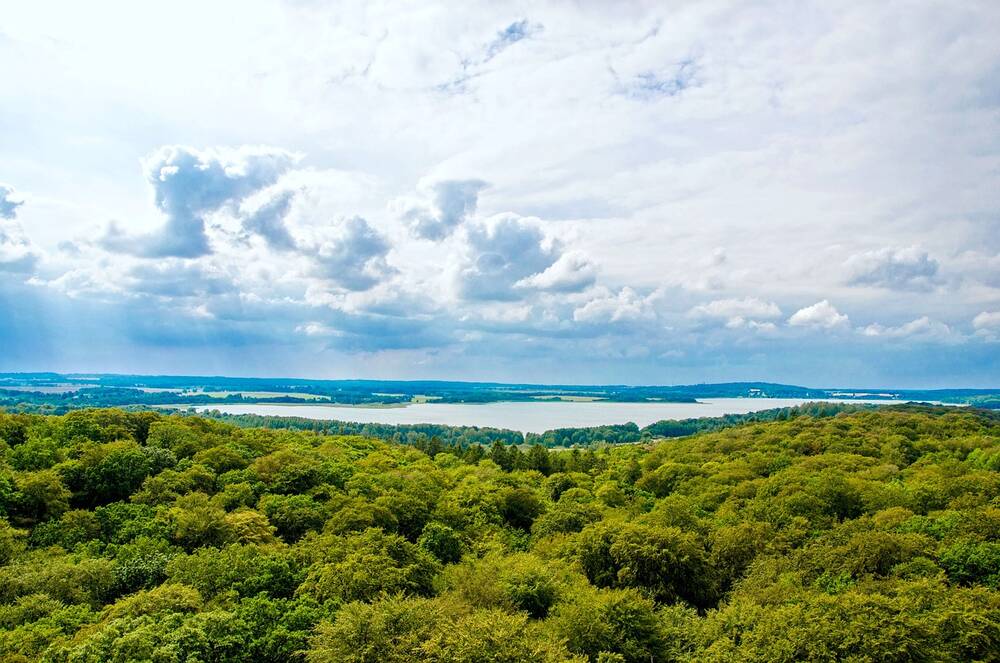In this page, we explain the various ways you can plan and prepare for BNG (Biodiversity Net Gain) in detail.
The 2021 Environment Act
The Environment Act 2021 is a guiding legislation in the UK. This Act introduces the mandatory Biodiversity Net Gain (BNG) requirement; a policy reshaping the nature of development projects and their role in environmental action.
The Act lays out that developers, in order to be granted permission to build from their local planning authority, must now contribute 10% towards Britain’s net biodiversity.
This is a way that environmentally harmful development can continue, in a way that leaves the environment better than before. This gives us a chance to challenge the prolonged decline of our natural biodiversity and lessens the risk of animal extinction and habitat destruction.
A Biodiversity Unit is a piece of land on which site biodiversity value has been measured. Developers, now aware of how much biodiversity loss their development plans will do, can buy specific Units that offer a biodiversity value increase that, after the 30 year mandated period, will result in a 10% biodiversity gain.
The 10% Biodiversity Net Gain Requirement
While some biodiversity offsetting schemes follow the principle of No Net Loss (NNL), the drastic damage from the development sector requires further measures. A 10% gain is an appropriate amount so that the mass habitat loss over time is not just maintained, but amended.
Various species are endangered due to habitat destruction from development, including pollinators that our species depend on for food security, air quality, soil health and more.
By quantifying biodiversity impacts, BNG encourages the much-needed habitat creation of richer, more diverse wildlife that are resilient and sustainable.
Planning for BNG: The Steps You Need to Take
For developers that must now think about BNG from 12th February 2024, they must use the statutory biodiversity metric to make structured measures of the biodiversity on their development site. It is key that a calculation is made pre-development and post-development.
Ideally, on-site BNG should be achieved, as the best option to go for. This is when the development site has enough space to make up for the loss on-site. This route, the developer will think about incorporating green infrastructure and spaces for wildlife into their builds to achieve the 10% objective.
If on-site BNG is not feasible, such as due to lack of space, the developers must then consider off-site BNG, to create development biodiversity value. This structure directly aligns with the mitigation hierarchy principle, favouring restoration as close to the destruction as opposed to far away where value is lost.
For the off-site route, developers can source Biodiversity Units on Gaia’s BNG Unit Marketplace. They can select ones that will, after 30 years, result in a 10% gain that more than compensates for the environmental harm from development.
The next step is downloading the biodiversity gain plan template, available for both standard and phased developments.
For projects impacting irreplaceable habitats, a compensation plan is necessary, along with biodiversity net gain register reference numbers for off-site units or proof of purchase for statutory biodiversity credits. Additionally, a habitat management and monitoring plan is required to manage significant on-site gains.
Phased developments demand both an overall and phase-specific biodiversity gain plan. After LPA approval within the planning policy, the biodiversity gain plan can be submitted, with planning permissions contingent upon local authority approval of this plan and the biodiversity metric tool calculation. A small sites metric is also available for non-major developments, mandatory for BNG from April 2024.
The LPA has an 8-week window to approve or refuse the plan, with approval allowing the project to commence. Failure to meet BNG requirements could result in enforcement actions, breaching the national planning policy framework, obligations, or legal agreements.
Completing a Biodiversity Net Gain Plan

What is a Biodiversity Net Gain Plan?
A Biodiversity Net Gain Plan is a standardised template that developers must submit to Defra (Department for Food and Rural Services), illustrating the structured measures and approach their project will take to positively impact biodiversity to the mandated amount.
The comprehensive document ensures that development proposals align with the statutory requirements, and the template guides developers to leave no detail missed and cover all measures to be able to continue their plans.
When to Submit Your Plan
Developers should submit their Biodiversity Net Gain Plan to the local planning authority (LPA) after their planning conditions have been approved.
This submission is a critical step in the planning process, as the development cannot commence until the LPA approves both the biodiversity gain plan and the biodiversity metric calculation.

What to Include
In the plan, a metric tool calculation must be shown to highlight the pre-development and post-development conditions. The biodiversity loss through development is required in order to see how much work needs to be done to meet the objective.
If impacting an irreplaceable habitat, the developer must also provide a compensation plan.
Off-site gains will include the register reference numbers, or if going down the last resort option of biodiversity credits, their proof of purchase.
The Habitat Management and Monitoring Plan (HMMP) is a separate complex document usually completed by ecologists. This explains the structured approach to securing the gain over 30 years in great detail.
Statutory Biodiversity Metric Calculation
The 4.0 statutory metric tool was developed by Defra with help from experts such as Natural England, Natural Resources Wales, the Environment Agency and Forestry England.
During the biodiversity net consultation, several speakers from appropriate sectors aided in shaping the metric so that it is a scientifically robust, easy-to-use standardised tool of measurement that alleviates concerns of BNG being too convoluted, by greatly streamlining the process.
Pre and Post Development Plans
All stages of planning in Biodiversity Net Gain (BNG) rely on the record of the development site’s original biodiversity before damage is done to the existing habitat. This measure, using the biodiversity metric, also calculates the biodiversity lost in the development process, and shapes the route the developer can take to meet the BNG objective.
The pre-development plan explores habitat types and conservation opportunities, assessing what biodiversity resides and how specific species can be restored through the BNG avenue. An impact assessment predicts the impact of the development on the local nature.
If the site is applicable for on-site BNG, the developer will now consider integrating green infrastructure into his development.
The post-development plan is a strict outline of the measures to enhance and restore habitats after the construction. Setting out a structured plan ensures that phased targets can be met and the project is streamlined.
Biodiversity Net Gain Register Reference Numbers
The Register for off-site BNG has recently launched. This means that after their BNG Units receive approval from their local planning authority, landowners will submit them to the Defra registry.
This acts as a public record for all land that has been officially registered as off-site Units, to check their authenticity, and to have a universal collection that is open to the public for developers to reference when sourcing Units. It also avoids duplication.
The listings on the registry will clearly display their location, land boundaries, biodiversity metrics, legal agreements, and other detailed information.
On Gaia’s BNG Marketplace, the landowners will include a Defra reference number within their BNG Listings once they have received it, and buyers can check this on the registry.
Statutory Biodiversity Credits Proof of Purchase
For developers unable to deliver on-site gains or find suitable Units for off-site gains, they must buy statutory biodiversity credits to meet the mandatory 10% gain.
Depending on the amount of biodiversity calculated to be lost in development, they purchase fractional credits directly through the government. These are much more expensive to encourage the other 2 options first where possible.
Purchases are non-refundable, and an official proof of purchase must accompany developers’ biodiversity plan submissions. This is a simple way to officiate the process and ensure all transactions are valid. The funds are managed by Natural England to deliver habitat enhancement and creation, outlined in the Environment Act 2021.
A Habitat Management and Monitoring Plan
A Habitat Management and Monitoring Plan (HMMP) is a plan that landowners must complete. It is a comprehensive guide that they may typically employ ecologists to administer.
It covers a range of detailed ecological assessments and outlines a clear structure of how their land will be managed and monitored over the 30 year period to achieve a significant biodiversity gain. On Gaia’s BNG Unit Marketplace, BNG listing information directly correlates with the HMMP information, to leave no room for confusion or error.
The plan includes plans to optimise wildlife value, safeguard habitats and track biodiversity improvements.
A Compensation Plan (If Irreplaceable Habitats Are to Be Impacted)
Some irreplaceable habitats will be impacted by off-site BNG, such as ancient English woodlands (some persisting since 1600) and blanket bog (thick, waterlogged peatlands).
In this situation, developers must complete a compensation plan, crucial for maintaining biodiversity, however this does not contribute towards the gain percentage. In compensation, the plan must include the creation, restoration or enhancement of habitats elsewhere that are of either greater or equal ecological value.
How to Submit Your Plan
To submit your Biodiversity Net Gain (BNG) plan, developers must follow a structured process after obtaining their planning permissions.
Full details can be found here:
https://www.gov.uk/guidance/submit-a-biodiversity-gain-plan
Once the planning permission is granted, developers submit this plan to local planning authorities for the mandatory BNG condition. It must receive written approval from the planning authority before any development begins. The BNG plan template, provided by Defra, is a guide that developers can use to finalise their plans. The plan goes on to be published in the LPA (Local Planning Authority)’s register.

